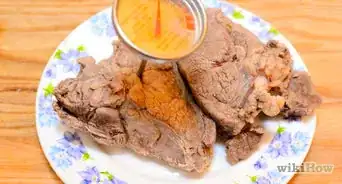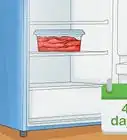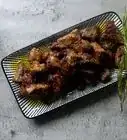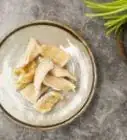This article was co-authored by wikiHow staff writer, Eric McClure. Eric McClure is an editing fellow at wikiHow where he has been editing, researching, and creating content since 2019. A former educator and poet, his work has appeared in Carcinogenic Poetry, Shot Glass Journal, Prairie Margins, and The Rusty Nail. His digital chapbook, The Internet, was also published in TL;DR Magazine. He was the winner of the Paul Carroll award for outstanding achievement in creative writing in 2014, and he was a featured reader at the Poetry Foundation’s Open Door Reading Series in 2015. Eric holds a BA in English from the University of Illinois at Chicago, and an MEd in secondary education from DePaul University.
There are 15 references cited in this article, which can be found at the bottom of the page.
The wikiHow Video Team also followed the article's instructions and verified that they work.
This article has been viewed 28,247 times.
Learn more...
You can tie up many different cuts of meat to keep them from losing their shape while they cook. Whether you’re trying to hold a filling in while the meat heats up, or you’re simply trying to maintain the roast’s appearance, tying a roast is the simple solution to keep your meal in place while it cooks.[1] To tie a roast, you’ll need butcher’s twine and a knife or pair of scissors to cut it.
Steps
Tying Your Butcher’s Knot
-
1Slide your twine underneath your roast. With your roast laid out lengthwise, slide the cut end of your twine underneath it. The cut end of the twine should be between you and the roast, while the uncut length of twine should extend away from you. Move the twine so that it’s resting a few inches or centimeters from the end of your roast.[2]
- Make sure that you’re using butcher’s twine and not jute twine. Butcher’s twine is sometimes called kitchen twine, and won’t burn in the oven.[3]
- The length of twine you need depends on the size of the roast and how tightly you plan on tying it. This can be hard to estimate, so just leave the roll of twine on the table as you work.
- The end you choose to start on doesn’t matter. Pick the side most comfortable for you.
-
2Pull the uncut length of twine over the roast towards you. With the cut end in your right hand and the uncut length of twine in your left, pull the uncut twine over the top of the meat towards you. Bring them together and pinch the junction where they meet with your left thumb and forefinger.[4]
- If you are left-handed, reverse the directions so that each piece of twine is in the opposite hand.
Advertisement -
3Wrap the cut end around the uncut end of the twine. Use your right hand to wrap the cut end around the uncut end by going over it counter-clockwise. Don’t pull it tight; there should be an inch-long opening where you just wrapped the twine.[5]
-
4Thread the remaining length of the cut end through the loop. With the uncut end held firmly in your left hand, pull the cut length of twine through the loop with your right hand by going through the bottom of the loop. While still using your right hand, pull it through all the way and tighten it so that it forms a knot.[6]
-
5Tighten your knot by pulling on both ends. Pull on both ends of the twine so that the knot rests tightly against the roast. The butcher’s knot is a kind of slip knot, and you can adjust it to be tighter or looser by pulling on the twine.[7]
-
6Secure your tie in place by forming a knot on top of the butcher’s knot. Once your butcher’s knot is resting firmly against the roast, take the remaining portion of the cut end and pull it across the uncut end. Then, twist the uncut end underneath the cut end and tighten it. Do this twice to form a knot.[8]
- Your butcher’s knot should be firmly pressed against the roast, but it shouldn’t be so tight that it’s pushing juices out of your meat.
- Do not cut off any of the remaining twine on your uncut end. You’ll need it to secure your roast later.[9]
Looping the Rest of the Roast
-
1Form your first loop by pulling your two sections together and rotating them. Hold the section of twine closest to the knot in your right hand, and hold the remainder of the twine in your left. Bring a section of uncut twine towards the section of cut twine in your right hand and cross the two pieces. Spin the loop shut by pulling your right hand around the left to close the junction where the two sections meet.[10]
- Make sure that the cut side of twine rests underneath the uncut twine when you twist your loop to slide it over the roast.
- The opening in the middle of the loop should be big enough to slide your roast through.
-
2Slide your first loop underneath the roast. Starting on the end of the roast that you’ve already tied, slide your roast through the loop that you’re holding by lifting the meat slightly and moving the twine. Once you’re a few inches further down from the knot, pull your loop tight by pressing the junction where your length of twine forms a loop downwards with your right hand while pulling the remaining length of twine with your left.
- Your two loops should connect at the top, wherever you chose to tighten the loop. Try to tighten your next set of loops along that same line.[11]
-
3Repeat this process until you’ve looped the entire roast. Continue to create loops and slide your roast through them in several inch-long increments. As long as it seems like the loops will keep your roast from moving around, it doesn’t really matter what the exact distance between them is.[12]
- It should look like there’s a single piece of twine running the entire length of your roast at the junction where you’ve tightened each loop.
Finishing Your Roast
-
1Finish your last loop and inspect it to make sure it is tight. Once you’ve reached the end of your roast, place your last loop so that it mirrors the butcher’s knot on the opposite side. Before flipping it, inspect the tension on the loops to ensure that they’re tight enough. If you need to tighten any of them, either pull on the remaining length of twine, or retie your loops so that they’re tighter.[13]
- It should look like a symmetrical grid after you finish your last loop.
-
2Flip your roast over. Turn your roast upside down on the cutting board or countertop so that you’re looking at the bottom of the roast. Try to line it up so that the line running between your loops on the bottom is in the middle of the roast.
-
3Run some uncut twine lengthwise back over the roast. This piece of twine should be long enough that you can tie it to the first knot you made. Once you’ve got a workable length pulled out, cut it from the original ball of butcher’s twine with a knife or scissors.[14]
- Be careful when estimating the amount of twine necessary to run over the roast. Too much twine is better than too little.
- An easy way to check is to try pulling your length of twine to the knot and then cutting above there. You can always cut any excess twine later.
-
4Pull your length of twine over and under each individual loop. You should still be looking at a set of parallel loops on what was originally the bottom of your roast. Take the length of twine that you have just cut, and wrap it under and over each individual loop of twine in a straight line towards the end you originally started with. Pull firmly after each time you wrap it to secure it to each individual loop.[15]
- This is securing the loops you’ve already made to make sure that they stay in place while cooking.[16]
-
5Flip your roast back over and tie the remaining length. You should still have at least a small length of twine dangling from your original butcher’s knot. Bring this length of twine together with the portion you have just used to secure the bottom of the roast. Wrap them around each other once and pull them to the roast. Wrap them around each other again and tighten it to form a knot.[17]
- If you still have any twine left over after your last knot, cut it with scissors or a knife.
Things You’ll Need
- Butcher’s twine
- Knife or scissors
References
- ↑ https://www.foodrepublic.com/2013/11/06/why-do-you-tie-a-roast/
- ↑ https://youtu.be/rFIwbUBiRSE?t=54
- ↑ https://www.latimes.com/style/la-fo-twine4-2009mar04-story.html
- ↑ https://youtu.be/rFIwbUBiRSE?t=61
- ↑ https://www.bbc.com/food/techniques/how_to_tie_a_butchers_knot
- ↑ https://www.bbc.com/food/techniques/how_to_tie_a_butchers_knot
- ↑ http://dish.allrecipes.com/tying-roasts/
- ↑ https://www.bbc.com/food/techniques/how_to_tie_a_butchers_knot
- ↑ https://youtu.be/rFIwbUBiRSE?t=198
- ↑ https://www.youtube.com/watch?v=rFIwbUBiRSE
- ↑ https://youtu.be/rFIwbUBiRSE?t=98
- ↑ https://youtu.be/rFIwbUBiRSE?t=107
- ↑ https://youtu.be/rFIwbUBiRSE?t=150
- ↑ https://youtu.be/rFIwbUBiRSE?t=156
- ↑ https://youtu.be/rFIwbUBiRSE?t=162
- ↑ https://youtu.be/rFIwbUBiRSE?t=168
- ↑ https://youtu.be/rFIwbUBiRSE?t=190

















































